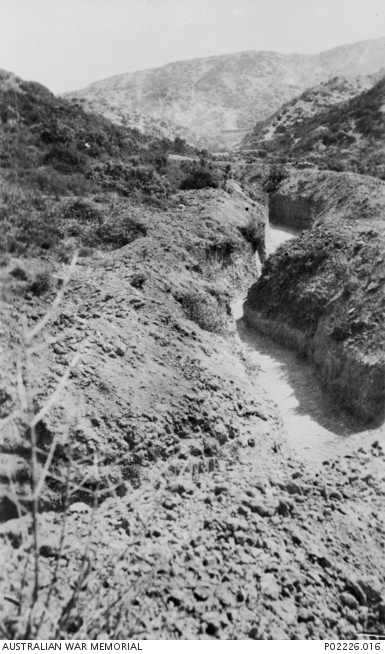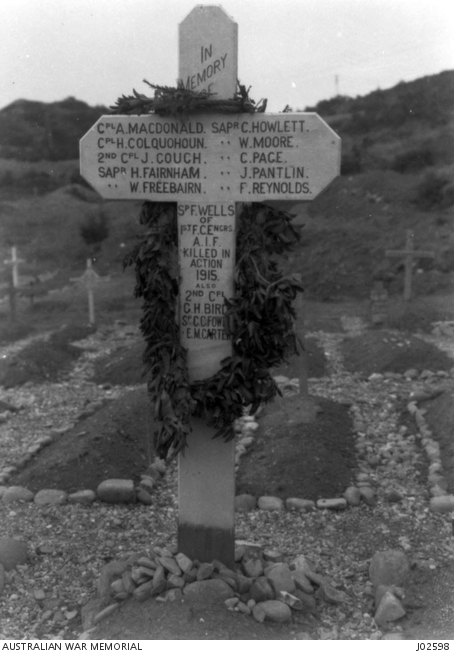
The June Diary AWM4 report from Gallipoli shows a major shift in the work required from the Engineers of the 1st FCE. While the month of May had been random employment maintaining and building jetties, constructing trenches and grading artillery roads, the whole offensive strategy was now focused on trenching and tunneling. The expert hands of surveyors, draughtsman, mining engineers and the sappers, would now underpin the campaign’s ability to sustain or gain valuable ground at Gallipoli.
The June war diary is full of detailed trench and tunnel data and the scope of works conducted by the engineers. The diary slowly builds through out the month and one can see the detail surrounding trenching and tunneling becoming more significant. The details may be shy of mentioning those men specifically involved, but it clearly shows the vast amount of work the engineers were engaged during the month of June.

Work detailed included the re- bedding and improving of existing saps, regrading of roads and gully’s. The continual repair and replacements of parapets. The construction of observation tunnels at “Courtney’s Post”, additional loophole preparations. Tunnel cross cuts and formation of listening galleries.
Very few days were involved in what was described as of a “general nature” as the enemy shelling on these days was too heavy, a reminder that they were always exposed to danger as the tunnelling and sapping was not so covert and was under constant scrutiny and engagement by the Turks.
The tunnelling strategy was equally important to the Turks, and the underground game of “tunnel – chess” between the Anzac’s and the Turk’s meant building listening trenches was vital to determining the next move, which trench or tunnel to “blow-in” or when to make a change of direction.
A short chronology of the June Diary AWM4 – 1st Field Company Engineers follows highlighting the men mentioned……………
June 3rd ….. non-commissioned officers 2/Cpl 110 Gordon Wilson, 2/Cpl 30 Donald Mackay, L/Cpl 66 Norman Masters volunteered for some “blow-in” work but an infantry raid had prevented the operation from proceeding.
11th June to 13th June
“Experiments commenced making , bomb screens of wire netting for the trenches, barbed wire obstacles for placement on trenches…….barbed wire entanglements placed in front of Barbed Wire Gully”
June 13th
“Lieut. Dyer behaved with great coolness in preparing and tamping charge and gallery in a cramped space 97 feet in, candle constantly going out owing to bad ventilation 22 feet down from the surface”
This was the just the start of a great display of heroics from Lieut Richard Dyer.
On another occasion specifically mentioned were..….”Sapper Hirst and Davis employed nightly on this job (a job identified by code numbers C8, C7a) and both doing good work in spite of being under fire every time they went out”…….…. June 14th
The list of men above was prepared by sapper 90 George Chisholm under the instructions of Lieut. Bachtold . These men were stationed at “Courtney’s Post” between June and August, this was their home for the next three months. Sketch 38 also above, is a trench and tunnel diagram as drawn by Lieut. Bachtold , showing the position of Courtney’s Post and positions of new work tunnel D10B and tunnel D14 . Lieut Bachtold had an initimate knowledge of D10 as he was not afraid to crawl around and lay barbed wire entanglements while under fire.
It is very possible some of the men on this list are in the header photo of Courtneys Post as it was taken in June 1915. Impossible as it is to identify them, it is somewhat comforting to see them going about their daily routine as ” Courtneys Post” had become home to many of the original sappers.
213 Roy Denning was wounded on the 16th June by shrapnel and thought it was simply a flesh wound until he realised it had pierced straight through his leather belt and only just missed his spine “by a whisker”. Roy was lucky to be wearing his belt. The doctors arrived quickly, warning Roy it was going to hurt, then removed the shrapnel with a knife, and he was then stretchered off to the hospital ship.

(Roy’s personal story is available on his own pages)
19th June…….250 Fred Wicks was not happy about his wounding either, he was happy to dismiss it as a minor flesh wound. He was wounded by shrapnel whilst delivering crates of biscuits. His wound was considered far more serious than he later described in his letters to his family, but that was Fred’s nature…………………..

(Fred’s personal story is available on his own page)
Both Fred Wicks and Roy Denning would return to Gallipoli, and would see the distance throughout the war and both would later distinguish themselves in the field.
On the 19th June sadly the sappers lost another original, Cpl 239 Hugh Colquhoun… died from wounds, the circumstances of which are still unknown. His name was later included with other engineers on the famous memorial cross……………..

(His memory and personal story is available on his page)
June 23rd……. “Lieut. Bachtold went out in front of D10 last night at great personal risk, laid a series of barbed entanglements in front of position. Rifle fire continuous during the whole time he was out from snipers concealed in valley”.………………Both Lieut Richard Dyer and Lieut. Henry Bachtold were officers who never hesitated to lead by example. Their early days at Gallipoli as young officers always willing to lead at the front was outstanding and just a taste of what was so characteristic of these great men.
June 25th…….Major Corlette was admitted to hospital with general debility.
June 26th……. also mentioned were …. Littler transferred to special duties records, Downton replaced Littler as Storeman and L/Cpl Oliver replaced Downton
June 28th……..35 Sapper Walter Robertson was wounded with rifle fire to head and nose. This “rough carpenter” was a very tough individual, he would return to Gallipoli and was later awarded a Military Medal……………………….
(His personal story is available on his page)
On the 30th June Lieut Biden had gone to hospital with diarrhoea.
For the officers and ranks of the various Field Companies, June was a heavy month of planning, preparing new trench’s and tunnels. The tunneling strategy was now a major commitment from the ANZAC Forces, and what became known as the “The German Officers Trench” had become a strategic target in the eyes of the command and would become the main focus for the ensuing months, ultimately leading to a number of assaults that would distinguish a few more of the originals in the field………………………….
Sources:AWM, NAA, NLA
Courtneys Post – home for many of the “originals” – Photo taken – June 1915 Gallipoli, Turkey – Courtesy NZ Government (http://mp.natlib.govt.nz/detail/?id=68369)
Link to PDF 1st FCE Diaries AWM4 June 1915
Link to PDF 1st FCE Diaries AWM4 June – August 1915
Anzac Digger -Roy & Lorna Denning






















